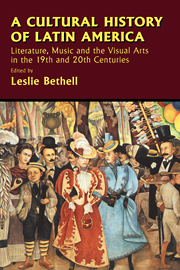 A Cultural History of Latin America
A Cultural History of Latin America 8 - Architecture, c. 1920–c. 1980
Published online by Cambridge University Press: 05 June 2012
Summary
INTRODUCTION
By the 1870s the majority of the newly independent Latin American countries appeared – to greater or less degree – to be on the road to social and political stability. Relative economic prosperity resulting from Latin America's accelerated integration into world economy during the following decades and the arrival of hundreds of thousands of immigrants from all over the world, but above all from Europe (especially the Mediterranean basin), had at least two important consequences for Latin American architecture. First, it brought skilled labour that was quite different from the local work-force; secondly, a new acculturation on a global scale meant exposure to styles and sensibilities distinct from those which had prevailed until then. Between the 1870s and the 1920s governments and the new rising bourgeoisie used architecture as one of the most visible means of giving themselves an aura of respectability, and they did so by imitating European and North American models.
During this period neo-classicism – refined or popular, as it was handled by masons steeped in the millennarian formulas of the Old World – began to disappear, giving way to eclectic designs typical of the late nineteenth century: neo-romanesque or neo-gothic, Italian Renaissance, Beaux-Arts, or simply the picturesque styles of the European countryside: Andalusian, Basque, Norman, Swiss or English, appropriated for suburban residences or homes built in the mountains or at the beach.
In general, architecture at the end of the nineteenth century met a common fate in nearly all the Latin American republics: there was a reaction against everything Spanish or Portuguese that might even remotely conjure up memories of colonial dependence.
- Type
- Chapter
- Information
- A Cultural History of Latin AmericaLiterature, Music and the Visual Arts in the 19th and 20th Centuries, pp. 369 - 392Publisher: Cambridge University PressPrint publication year: 1998
